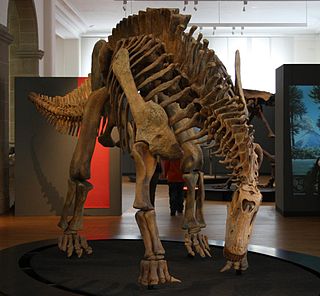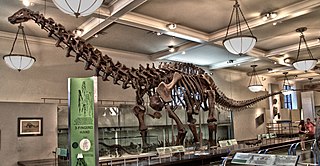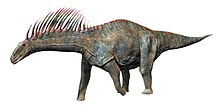
Apatosaurus is a genus of herbivorous sauropod dinosaur that lived in North America during the Late Jurassic period. Othniel Charles Marsh described and named the first-known species, A. ajax, in 1877, and a second species, A. louisae, was discovered and named by William H. Holland in 1916. Apatosaurus lived about 152 to 151 million years ago (mya), during the late Kimmeridgian to early Tithonian age, and are now known from fossils in the Morrison Formation of modern-day Colorado, Oklahoma, New Mexico, Wyoming, and Utah in the United States. Apatosaurus had an average length of 21–23 m (69–75 ft), and an average mass of 16.4–22.4 t. A few specimens indicate a maximum length of 11–30% greater than average and a mass of approximately 33 t.

Diplodocids, or members of the family Diplodocidae, are a group of sauropod dinosaurs. The family includes some of the longest creatures ever to walk the Earth, including Diplodocus and Supersaurus, some of which may have reached lengths of up to 42 metres (138 ft).

Barosaurus was a giant, long-tailed, long-necked, plant-eating sauropod dinosaur closely related to the more familiar Diplodocus. Remains have been found in the Morrison Formation from the Upper Jurassic Period of Utah and South Dakota. It is present in stratigraphic zones 2–5.

Nemegtosauridae is a family of titanosaurian sauropod dinosaurs based on their diplodocid-like skulls. Only three species are known: Nemegtosaurus, Quaesitosaurus and possibly Tapuiasaurus, each from the Cretaceous.

Amargasaurus is a genus of sauropod dinosaur from the Early Cretaceous epoch of what is now Argentina. The only known skeleton was discovered in 1984 and is virtually complete, including a fragmentary skull, making Amargasaurus one of the best-known sauropods of its epoch. Amargasaurus was first described in 1991 and contains a single known species, Amargasaurus cazaui. It was a large animal, but small for a sauropod, reaching 9 to 13 meters in length. Most distinctively, it sported two parallel rows of tall spines down its neck and back, taller than in any other known sauropod. In life, these spines could have stuck out of the body as solitary structures that supported a keratinous sheath. An alternate hypothesis, now more favored, postulates that they could have formed a scaffold supporting a skin sail. They might have been used for display, combat, or defense.
Suuwassea is a genus of dicraeosaurid sauropod dinosaur found in the Upper Jurassic strata of the Morrison Formation, located in southern Carbon County, Montana, United States. The fossil remains were recovered in a series of expeditions during a period spanning the years 1999 and 2000 and were described by J.D. Harris and Peter Dodson in 2004. They consist of a disarticulated but associated partial skeleton, including partial vertebral series and limb bones.

Diplodocoidea is a superfamily of sauropod dinosaurs, which included some of the longest animals of all time, including slender giants like Supersaurus, Diplodocus, Apatosaurus, and Amphicoelias. Most had very long necks and long, whip-like tails; however, one family are the only known sauropods to have re-evolved a short neck, presumably an adaptation for feeding low to the ground. This adaptation was taken to the extreme in the highly specialized sauropod Brachytrachelopan. A study of snout shape and dental microwear in diplodocoids showed that the square snouts, large proportion of pits, and fine subparallel scratches in Apatosaurus, Diplodocus, Nigersaurus, and Rebbachisaurus suggest ground-height nonselective browsing; the narrow snouts of Dicraeosaurus, Suuwassea, and Tornieria and the coarse scratches and gouges on the teeth of Dicraeosaurus suggest mid-height selective browsing in those taxa. This taxon is also noteworthy because diplodocoid sauropods had the highest tooth replacement rates of any vertebrates, as exemplified by Nigersaurus, which had new teeth erupting every 30 days.

Rebbachisauridae is a family of sauropod dinosaurs known from fragmentary fossil remains from the Cretaceous of South America, Africa, North America, Europe and possibly Central Asia.

Dicraeosauridae is a family of diplodocoid sauropods who are the sister group to Diplodocidae. Dicraeosaurids are a part of the Flagellicaudata, along with Diplodocidae. Dicraeosauridae includes genera such as Amargasaurus, Suuwassea, Dicraeosaurus, and Brachytrachelopan. Specimens of this family have been found in North America, Asia, Africa, and South America. In 2023, a dicraeosaurid fossil was discovered in India for the first time. Their temporal range is from the Early or Middle Jurassic to the Early Cretaceous. Few dicraeosaurids survived into the Cretaceous, the youngest of which was Amargasaurus.

Brachytrachelopan is a short-necked sauropod dinosaur from the Late Jurassic of Argentina. The holotype and only known specimen was collected from an erosional exposure of fluvial sandstone within the Cañadón Calcáreo Formation on a hill approximately 25 kilometres (16 mi) north-northeast of Cerro Cóndor, Chubut Province, in west-central Argentina, South America. Though very incomplete, the skeletal elements recovered were found in articulation and include eight cervical, twelve dorsal, and three sacral vertebrae, as well as proximal portions of the posterior cervical ribs and all the dorsal ribs, the distal end of the left femur, the proximal end of the left tibia, and the right ilium. Much of the specimen was probably lost to erosion many years before its discovery. The type species is Brachytrachelopan mesai. The specific name honours Daniel Mesa, a local shepherd who discovered the specimen while searching for lost sheep. The genus name translates as "short-necked Pan", Pan being the god of the shepherds.

Dyslocosaurus is the name given in 1992 to a genus of sauropod dinosaur from the Late Jurassic Period of Wyoming, North America.

Neosauropoda is a clade within Dinosauria, coined in 1986 by Argentine paleontologist José Bonaparte and currently described as Saltasaurus loricatus, Diplodocus longus, and all animals directly descended from their most recent common ancestor. The group is composed of two subgroups: Diplodocoidea and Macronaria. Arising in the early Jurassic and persisting until the Cretaceous-Paleogene extinction event, Neosauropoda contains the majority of sauropod genera, including genera such as Apatosaurus, Brachiosaurus, and Diplodocus. It also includes giants such as Argentinosaurus, Patagotitan and Sauroposeidon, and its members remain the largest land animals ever to have lived.

Australodocus is a genus of sauropod dinosaur that lived during the Late Jurassic period, around 150 million years ago, in what is now Lindi Region, Tanzania. Though initially considered a diplodocid, recent analyses suggest it may instead be a titanosauriform.
Amargatitanis is a genus of dicraeosaurid sauropod dinosaur from the Barremian-age La Amarga Formation of Neuquén, Argentina. It is known from a single, incomplete postcranial skeleton consisting of a partial hindlimb, ischium, and two vertebrae. These remains were unearthed by Argentine paleontologist José Bonaparte in 1983 during an expedition by the Museo Argentino de Ciencias Naturales and later described as a new genus and species, Amargatitanis macni by Sebastián Apesteguía. The genus name comes from the words Amarga, where the fossils were collected, and titanis meaning "titan". Its species name is in reference to the MACN, where the remains are stored.

Apatosaurinae is a subfamily of diplodocid sauropods, an extinct group of large, quadrupedal dinosaurs, the other subfamily in Diplodocidae being Diplodocinae. Apatosaurines are distinguished by their more robust, stocky builds and shorter necks proportionally to the rest of their bodies. Several fairly complete specimens are known, giving a comprehensive view of apatosaurine anatomy.

Kaatedocus is a genus of flagellicaudatan sauropod known from the middle Late Jurassic of northern Wyoming, United States. It is known from well-preserved skull and cervical vertebrae which were collected in the lower part of the Morrison Formation. The type and only species is Kaatedocus siberi, described in 2012 by Emanuel Tschopp and Octávio Mateus.

Leinkupal is a genus of diplodocine sauropod known from the Early Cretaceous of the Bajada Colorada Formation, southeastern Neuquén Basin in the Neuquén Province of Argentina. It contains a single species, Leinkupal laticauda.

Lingwulong is a genus of dicraeosaurid sauropod dinosaur from the Middle Jurassic of what is now Lingwu, Yinchuan, Ningxia, China. The type and only species is L. shenqi, known from several partial skeletons. It is the earliest-aged neosauropod ever discovered, as well as the only definite diplodocoid from east Asia.

Pilmatueia is a diplodocoid sauropod belonging to the family Dicraeosauridae that lived in Argentina during the Early Cretaceous. Its type and only species is Pilmatueia faundezi. Pilmatueia was probably closely related to other South American dicraeosaurids such as Amargasaurus. Pilmatueia had relatively pneumatic vertebrae compared to other dicraeosaurids, which were otherwise characterized by a reduction in pneumaticity relative to other sauropods. Pilmatueia dates to the Valanginian, an age of the Cretaceous period for which dinosaur faunas are poorly known.

Bajadasaurus is a genus of sauropod dinosaur from the Early Cretaceous epoch of northern Patagonia, Argentina. It was first described in 2019 based on a single specimen found in 2010 that includes a largely complete skull and parts of the neck. The only species is Bajadasaurus pronuspinax. The genus is classified as a member of the Dicraeosauridae, a group of relatively small and short-necked sauropods.





























